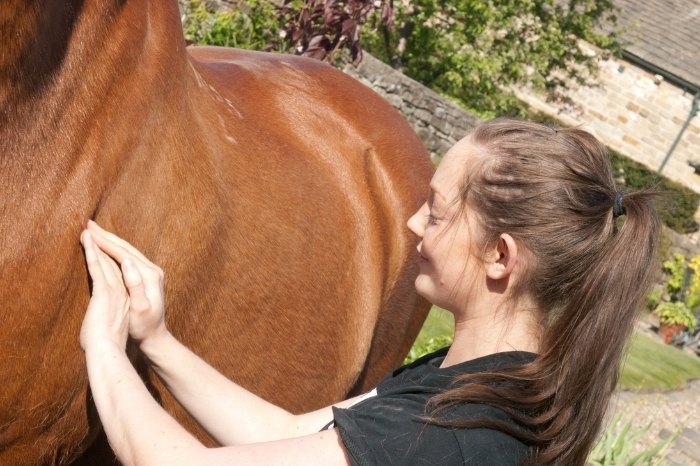Last Updated on July 27, 2022
Being able to recognize the main horse tying up symptoms is vital to be able to help diagnose and treat this uncomfortable condition quickly. Let’s find out everything you need to know about tying up in horses, including how to diagnose, treat, and prevent this painful condition.
What Is Tying Up In Horses?
Tying up is the name given to a horse that has suffered from muscle damage, similar to cramp in humans. Although many people think of tying up as a disease in itself, it is actually a symptom that occurs because of a range of muscular disorders of horses.
When a horse ties up, the muscles become stiff, hard, and painful to move. This can occur on any of the muscles of the body, but most commonly in the large muscle groups of the hindquarters. You may have heard of tying up referred to as azoturia in the past, but in more recent times the causes of tying up in horses have been reclassified.
The correct name for muscular damage in horses is rhabdomyolysis, and this can manifest for a variety of reasons:
-
Exertional Rhabdomyolysis (ER)
ER typically occurs during or after exercise. It can be a one-off event, sporadic rhabdomyolysis, or may recur on a regular basis, chronic rhabdomyolysis. The chronic forms of ER are further broken down into recurrent exertional rhabdomyolysis (RER) and polysaccharide storage myopathy (PSSM).
-
Non-exercise Associated Rhabdomyolysis
The other types of rhabdomyolysis in horses are not associated with exercise and can be triggered by inflammatory, nutritional, or toxic agents.
-
Traumatic Rhabdomyolysis
The final type of tying up occurs as a result of trauma to the muscle, such as a crush injury. One example of this is post-operative myopathies, where the blood supply to the muscle has been compromised following a long period of recumbency.
Today we will mainly discuss sporadic exertional rhabdomyolysis; that is when the condition occurs as one-off event following a period of exercise. If your horse suffers from recurrent tying up, or if the symptoms are severe and unresponsive to treatment, then your veterinarian may recommend further diagnostic tests to investigate other causes of tying up.
What Are The Main Horse Tying Up Symptoms?
No matter what the cause of tying up in horses, the clinical signs are all very similar. The horse will feel a lot of pain in its muscles, making it very reluctant to move. When the horse can be persuaded to move it may appear stiff or lame, or have a stilted gait.
Horses that have tied up often also sweat profusely, and can have muscle tremors or quivering. The affected muscle may feel hard and be painful when palpated.
In severe cases of tying up, the horse may have dark brown urine. This is a result of muscle breakdown and is a medical emergency. If left untreated, this can lead to irreversible kidney damage.
Click Here to Get Info About:
How Is Tying Up In Horses Diagnosed?
If your veterinarian suspects that your horse has tied up, they will normally recommend blood work to check levels of muscle enzymes and assess kidney function. A urine sample may also be advised to detect the presence of muscle breakdown and electrolyte imbalances.
In severe or recurrent cases of tying up, muscle biopsies can be used to attempt to identify the underlying cause. Genetic testing can also be used to detect the presence of genetic abnormalities that can predispose horses to tying up.
Best Treatment For Tying Up In Horses
Horses that have tied up should be thought of as a medical emergency, especially if they show symptoms such as dark urine, sweating, and reluctance to move. Your veterinarian should be consulted even if the symptoms are mild, as your horse may be experiencing considerable discomfort. Exercise should be stopped immediately, and the horse should not be forced to move unnecessarily.

Horses that have tied up should be given pain relief and medication to help relax the muscles. They may require fluid therapy to maintain hydration and replenish lost electrolytes. Your veterinarian will carry out repeated blood and urine tests to assess the response to treatment.
Summary
So, as we have learned, the main horse tying up symptoms include a stiff or stilted gait, with a reluctance to move, and abnormal sweating. There are many reasons why horses tie up, and if your horse ties up on a regular basis then your veterinarian may suggest further diagnostic tests. Horses that have tied up are treated with pain relief, muscle relaxants, and fluid therapy.
We’d love to hear your thoughts on horse tying up symptoms, diagnosis, and treatment! Have you ever owned a horse that was prone to tying up on a regular basis? Or maybe you’ve got some questions about the different horse tying up symptoms? Leave a comment below and we’ll get back to you!
FAQ’s

Kate Chalmers is a qualified veterinary nurse who has specialized in horse care for the vast majority of her career. She has been around horses since she was a child, starting out riding ponies and helping out at the local stables before going on to college to study Horse Care & Management. She has backed and trained many horses during her lifetime and competed in various equestrian sports at different levels.
After Kate qualified as a veterinary nurse, she provided nursing care to the patients of a large equine veterinary hospital for many years. She then went on to teach horse care and veterinary nursing at one of the top colleges in the country. This has led to an in-depth knowledge of the care needs of horses and their various medical ailments, as well as a life-long passion for educating horse owners on how to provide the best possible care for their four-legged friends.
Kate Chalmers BSc (Hons) CVN, Dip AVN (Equine) Dip HE CVN EVN VN A1 PGCE

